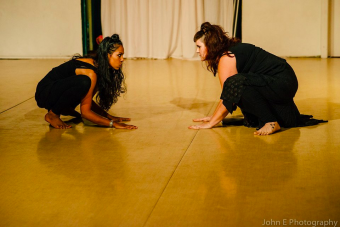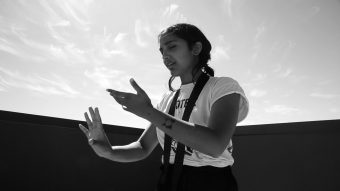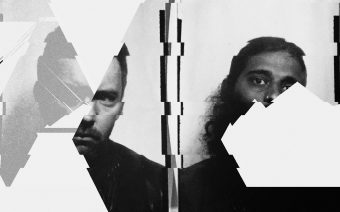This article is written by the curator in conversation with the curated for the upcoming triple-bill of aural, visual and poetic explorations of ritual in ‘Resonant Lines’ presented by the National Institute of Dramatic Art (NIDA) Melbourne and Multicultural Arts Victoria for Mapping Melbourne 2017. The triple-bill is birthed out of a collaboration between artists from South Asian and Euro-Australian backgrounds. Resonant lines is performed by Aarti Jadu, Nithya Iyer, Luna-Mrozik Gawler, Devika Bilimoria, Sudeep Lingamneni and Andrew McLaughlin.
Ritual is a loaded term encompassing a pastiche of the sacred, the secular and the profane. The reading of ritual through the indicators of structure, process, experience, function, ideology and frame enable the act of multi-sensorial meaning-making. Performative interventions of ritual provide fissures by creating a liminal space – one that is fluid and transitory, a state of in-betweenness.
Dancer and movement artist Nithya Iyer notes that the very act of creating and participating in ritual allows for individual agency in defining one’s self and their connection to the world. These acts become creators of meaning, interpreters of identities and disruptors of hierarchies. The study of ritual is inherently fraught with complexity and I do not wish to deny the depth of its multiplicity.
Iyer continues, ‘For some it connects us to an intangible sense that there is something greater than our individual self—a universe, a god, a consciousness, a mystery—that we are connected to and belong with. This includes much religious worship where there is a sense of acting in dialogue with the other. For others, it simply is an abstract act of being with one’s self meaningfully or introspectively, like drinking a glass of wine, writing in a journal, taking a walk or listening to music. Rituals like family dinners and birthday celebrations also allow us to connect to a shared sense of humanity and community’. This slippage of categorisation empowers an interplay of possibilities in a performative sphere.

The articulation of ritual through the body shifts perceptions of temporality, spatiality, identity and community. It is in this nexus that the transformative power of ritual thrives. Disrupting the concept of linear time, ritual draws upon action, repetition and continuum to affect consciousness. Ritual also reimagines the inner landscape, reconfigures the relationship to place and regenerates a safe space to create the ideal conditions for a transcendental experience. Singer and vocal artist Aarti Jadu explains that the parts of ritual that she personally finds helpful and beautiful are: its power to create integrity, allow for a space of gratitude and intent and unpack personal and universal benefit’.
The negotiation of identity and community in ritual, particularly in the Australian context, can provide an embodied understanding of dynamic racial and cultural inter-relationships, mediated through live performance and digital technologies. Poet and performance-maker Luna-Mrozik Gawler elaborates, ‘The ritual process is both collective and individual, and while there are traditions to inform them or a greater community to sometimes witness their performance, it is ultimately the individual who creates, and no person is pardoned from change.

‘The ritual occurs between a physical act, an immaterial intention and the greater unknown at which it is directed, and this is a fluid space. As needs change, so too does the ritual, which raises interesting questions when it comes to a present-day, multicultural Australia where ancient traditions exist alongside contemporary and new-age beliefs. A ritual is a repetitions process, but the consistency might arise from any one part of a practice – the physical act itself, the immaterial intention or the greater unknown it is directed toward, while the rest might be in a constant state of change’.
This flux facilitates a state of flow for the self. Punk-rock musician and sound lecturer Andrew McLaughlin describes the process of strumming the guitar, shredding the vocals and synthesising the rhymes and rhythms as a meditative act. Composer and sound artist Sudeep Lingamneni reveals that he is interested in unearthing the essence of the music, excavating the forces which work to create and produce sound and tracing the trajectory of its travel. They both concur that it is as much about what is left out as it is about what is left in. Having studied and worked side-by-side for a decade at University, they’re excited about their first collaboration and are embracing the lack of method to the madness.
In thinking through secular pursuits of ritual, Gawler finds the shamanic teachings from Australia particularly useful. She observes that the course of connecting with Mother Nature, asking the natural world for guidance, clearing spaces with smoke or sound are things that are accessible and habitual, even when she is inclined toward skepticism or secular thinking.

Ritual is not without its own problems. Some rituals can be archaic, violent and discriminatory. Others can be a rite of passage, forcefully executed and denying of agency. I remain wary of romanticising the idea of ritual as a whole without these considerations taken into account whilst I also remain fascinated by the micro-personal and macro-political reverberations of ritual.
Finality is a myth. Challenges manifest. Questions remain. Rituals evolve. Iyer echoes this internal conflict, ‘Has the ritual remained? Technically, yes. But what else has occurred to preserve that ritual in an evolving society? What impact does this have on the intention of that ritual in the first place? These conflicts have always stood out to me’.
‘Resonant Lines’ is designed to culminate in a six-way improvisation between the artists. The layering of backgrounds, disciplines and beliefs in a process of creation that is not pre-meditated is intended to highlight the subjectivity of the self to the audience, with the larger notion of understanding the self too as the audience. The spontaneity will hopefully negotiate resonances and dissonances in real-time without being able to negate the past and the future as influencers of the present moment. After all, ritual almost always entails risk.
This is a free event. Please register here.

